Do I have a digital addiction?
Digital addiction: A rapidly growing epidemic

Digital Detox Pt.2: Invisible digital addiction
“I’m not addicted, I can stop anytime”. Does this sound familiar?
Whether it was the ‘need’ to socialise every weekend in my younger years or the ‘need’ for coffee in more recent years, those words have escaped my lips. Addictions can take any form, however the theme of this article is digital addiction.
Digital addiction is one of the fastest-growing addictions. A comprehensive meta-analysis covering over 2 million individuals from 64 countries showed that 1/4 of the general population could be affected by at least one subtype of digital addiction.
In the opening post of this digital detox series, Amy introduced the effects of dopamine and cortisol, along with reasons to consider a dopamine detox. This article explores why digital addiction affects us all.
Why should I care about digital addiction?
Our choice of diet affects our physical health. Repeated 'sugar spikes' negatively affect the body's regulation of fuel. Similarly, the mental diet we choose affects our mental health. Artificial and excessive 'dopamine spikes' disrupt the brain's reward system, making us more prone to addiction.
It's not an exaggeration to say that digital addictions hijack our brain patterns. Thoughts, emotions and eventually actions are all influenced. Digital addiction drives us to prioritise short-term dopamine, undermining our conscious, purposeful growth intentions. The invisible and autopilot nature of these addictions makes them worthy of our scrutiny.
Consequences of digital addiction
Over time, the consequences of just one symptoms become magnified.

Let’s look briefly at research on some of these symptoms.
- The International Journal of Environmental Research and Public Health found digital addiction is accompanied by severe sleep loss, emotional distress, depression, and memory dysfunction.
- Impairments in working memory are linked to internet addiction behaviors. One study focused specifically on popular ‘short form videos’ (i.e Instagram / YouTube / Tik Tok ‘reels’)
- A longitudinal study demonstrated that prolonged problematic use of social media reduces in person social skills and increases feelings of loneliness.
- Long term television watching of 3.5 hours or more showed cognitive effects. Consequences included impaired brain processing and reduced volume in the frontal cortex. A different major longitudinal study associated an increased risk of Alzheimer’s disease for older adults who watch television for more than 3.5 hours.
We can appreciate how time efficency and life quality is impacted by uncontrolled digital habits. Excessive time on digital addictions robs us of time for important duties and relationships.
But I’m not addicted.... am I?

The above illustration is not intended as an insult to gamers or to belittle a child’s distress when instructed to take an activity break. A child’s reaction offers insights into the psychology of addictive habits across all ages.
Like a child, an adults brain quickly becomes accustomed to dopamine hits which create changes in the brain which feel genuinely uncomfortable. Research shows that peripheral blood dopamine levels are significantly higher in individuals with internet addiction. These levels correlate positively with weekly online time.
Stanford psychiatrist Anna Lembke shows in her book ‘Dopamine Nation’ that the brains response to increased rewards is to decrease dopamine below the natural baseline. This is not the pleasant experience you ordered.
As adults we may mask internal frustration when our dopamine activity is interrupted or postponed. However, the underlying brain activity is very similar. Unlike children, adults internalise and dimiss these feelings, which makes them harder to acknowledge and address.
Not all habits are necessarily addictions. However our reaction to having to skip a habit can offer some insight into how ‘addictive’ it has become for us. How do we react to the 'interuption' when our phone dies or the WiFi cuts out?
Breaking digital addictions isn’t a simple question of willpower or maturity. Rather, it is addressing the deeply rooted physiological withdrawals. A phased ‘detox exit/reduction’ is often the most effective long term strategy.
Will you take the test?
Individuals with a digital addiction typically experience intense cravings and are compelled to prioritise digital activities above other commitments. Their usage patterns can extend late into the night and often resume immediately upon waking, creating a cycle that bookends their sleep.
☑️ The short Digital Addiction Test offers insightful questions for honest reflection.
The Dopamine and Cortisol Cycle Revisited
Let's revisit the dopamine and cortisol cycle in Digital Detox Pt.1, and add addiction and the detox exit into the equation.

Feeding the addiction (Step 3) perpetuates the cycle. We have to make a commitment to break the cycle before Step 1 - before dopamine exposure occurs. This requires gradual, measured withdrawal from dopamine-triggering activities.
Some activities are objectively harder to reduce/quit than others, but breaking free from them brings greater benefits.
The axis of digital addiction
The first article of this this series, identified three such culprits that are greatly addictive, making them harder to quit. The below graphic shows each of these culprits with their dopamine/cortisol connection.

We will revisit each of these again with a closer focus of addiction, temptation and impact. Even if you feel watching the news is an ‘evening ritual’ and social media scrolling is just ‘how you start your day’ - these routines merit a place in your review crosshairs.
On Screen Entertainment (Dopamine + Cortisol)

- Temptation factors: Exhausation, overwhelm, escape.
- Impact: Time consumption, reduced mental resilience, reduced brain function, impaired sleep quality.
On screen entertainment triggers both dopamine from reward anticipation and cortisol from stress-inducing content. Action or violent entertainment trigger measurable stress responses—elevated cortisol, increased heart rate, and higher blood pressure. Intense gaming produces similar effects.
Research shows that on-screen entertainment alters brain chemistry and stress hormone regulation, creating the conditions for psychological dependency, or addiction. The research previously mentioned indicates lasting effects when daily viewing exceeds 3 hours.
Suggestions for consideration:
- Employ a timer plug to automatically switch on and off your entertainment devices/WIFI.
- Limit daily viewing to under 3 hours. Use gradual withdrawl if this is difficult.
- Be mindful of entertainment choices close to bedtime.
Negative News Consumption (Cortisol)

- Temptation factors: Negativity bias, curiosity, helplessness. The appealing option to be ‘spoon fed’ news bites without needing to do personal research.
- Impact: Decision programming, elevated fear, becoming a ‘repeater station’ for external views.
The expression ‘the news is programming’ accurately reflects the current day situation. Main stream media outlets generally prioritise engagement through emotional content. Fear and outrage drive views and clicks while repetition ensures the message 'sticks'. Positive news does not have the same effect.
Papers such as "The Scary World Syndrome" highlight how a person’s worldview becomes disproportionately shaped by media-presented threats rather than their own individual risk assessment. This effects both their decision making and mental health.
In recent years the COVID-19 period was a powerful example of this. Multiple peer-reviewed studies have concluded that the endless fear based news surrounding COVID-19 significantly increased sensitivity to fear and had profound mental health consequences. This period saw a 23% increase in cortisol levels across the general population. Research revealed that the prolonged fear-based messaging had devastating mental health consequences. By the time society 'reopened', the mental health damage had already been done, with many still 'living in fear'.
Consistent fear-based messaging across global news networks creates sustained stress responses (cortisol) and repetition amplifies the psychological impact.
Scripted repetition didn't begin with the COVID-19 years. In 2018, the Sinclair Broadcast Group's nearly 200 anchors delivered identical scripts word-for-word, as shown in the below video.
The infamous ‘Sinclair Broadcast Group script’ in 2018
If individuals then also repeat news headlines without examination, they become an extension of the scripting. They are in effect 'repeater stations’, rather than independent critical thinkers. Repeating negative news headlines reinforces the stress response and keeps your cortisol levels elevated, consolidating those memories more deeply. If you are tempted to add a ‘fear based’ news headline into a conversation, why not first take the time to examine the bias behind the story and the data/funding behind the source?
Suggestions for consideration:
- Consider eliminating or at least reducing exposure to main stream news media. See how you notice changes in your mental state after implementation.
- Accept there is no main stream media source without bias, and exercise caution repeating ‘fear based’ headlines.
- Look behind the headline. ‘Follow the data’ then ‘follow the money’ to ascertain who funds the source and identify conflicts of interest.
Social Media (Dopamine)

- Vulnerability factors: Curiosity, desire of external validation, desire for popularity or to ‘fit in’ (group think)
- Impact: Diluted or absent self identity and values, inaccurate comparison and idolisation with other individuals, impaired mental health, depression, reduced in person social skills.
When it comes to delivering dopamine hits, few easily accessible options exist that can rival the ‘effectiveness’ of social media. The line between casual social media use and ‘identity affirming addiction’ is a precarious tightrope. This is largely due to algorithms that learn our likes.
More insidious than the unprecedented time that can be consumed by these platforms is the social validation triggers. These platforms gamify ‘pseudo popularity’ creating neurochemical responses that are similar to substance addiction. Everyone wants to be liked and be popular. Regardless of our conscious awareness of these artificial metrics, our brains can easily be trained to view this ‘fake popularity’ as the real thing.
The desire for social media popularity and validation can lead to problematic behaviors. Social media can be a black hole for warped social comparison and ‘external validation dependency’ as one study showed. In this ‘artificial reality’ users often plummet down negative thinking spirals of inadequacy, potentially leading to low self esteem.
If left unchecked, self identity is drained away and replaced by a singular desire to be popular online. ‘Online identity’ replaces ‘in person identity’. Follows, likes and 'online popularity' then becomes both the measuring stick for individual value and collective envy. The artificial nature of online interactions can impair authentic in-person communication and social skills leading to further problems.
It is no wonder studies show strong linear associations between social media use intensity and depression, anxiety, and decreased self-esteem.
Suggestions for consideration:
- Remove social media apps from your phone and reduce time on each. Start by going 1 day without a particular channel and repeat for all others. Gradually increase this until urges subside.
- Avoid using social media first thing in the morning and last thing at night where possible.
- Once you've mastered going several days without a social media channel, test your ‘addiction level' by eliminating the channel/s for 1 month.
- Use apps such as One Sec to cause ‘friction’ in autopilot habits.
Breaking free
Although this article has been more forceful than usual, the subject matter of addiction merits serious attention. Seeing the potential effects of digital addictions can strengthen your determination to kick any you are experiencing to the curb.
It is possible to break free from any digital addiction. Digital technology can have many benefits if used in a conscious, balanced way. In the next article we will build on the suggestions here with a full plan for freedom from digital addiction.
Part of the Digital Detox series

